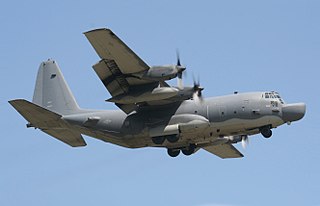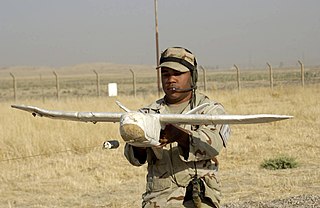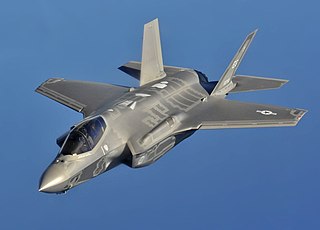 W
WThe Lockheed Martin A-4AR Fightinghawk is a major upgrade of the McDonnell Douglas A-4M Skyhawk attack aircraft developed for the Argentine Air Force which entered service in 1998. The program was named Fightinghawk in recognition of the F-16 Fighting Falcon, which was the source of its new avionics.
 W
WThe Bell V-280 Valor is a tiltrotor aircraft being developed by Bell and Lockheed Martin for the United States Army's Future Vertical Lift (FVL) program. The aircraft was officially unveiled at the 2013 Army Aviation Association of America's (AAAA) Annual Professional Forum and Exposition in Fort Worth, Texas. The V-280 made its first flight on 18 December 2017 in Amarillo, Texas.
 W
WThe Lockheed AC-130 gunship is a heavily armed, long-endurance, ground-attack variant of the C-130 Hercules transport, fixed-wing aircraft. It carries a wide array of ground attack weapons that are integrated with sophisticated sensors, navigation, and fire-control systems. Unlike other modern military fixed-wing aircraft, the AC-130 relies on visual targeting. Because its large profile and low operating altitudes of approximately 7,000 feet make it an easy target, its close air support missions are usually flown at night.
 W
WThe Lockheed Martin EC-130 series comprises several slightly different versions of the Lockheed C-130 Hercules that have been and continue to be operated by the U.S. Air Force and, until the 1990s, the U.S. Navy.
 W
WThe Lockheed HC-130 is an extended-range, search and rescue (SAR)/combat search and rescue (CSAR) version of the C-130 Hercules military transport aircraft, with two different versions operated by two separate services in the U.S. armed forces.
 W
WThe Lockheed Martin KC-130 is a family of the extended-range tanker version of the C-130 Hercules transport aircraft modified for aerial refueling. The KC-130J is the latest variant operated by the United States Marine Corps, with 48 delivered out of 79 ordered. It replaced older KC-130F, KC-130R, and KC-130T variants, while one USMC reserve unit still operates 12 KC-130T aircraft.
 W
WThe Lockheed MC-130 is the basic designation for a family of special mission aircraft operated by the United States Air Force Special Operations Command (AFSOC), a wing of the Air Education and Training Command, and an AFSOC-gained wing of the Air Force Reserve Command. Based on the Lockheed C-130 Hercules transport, the MC-130s' missions are the infiltration, exfiltration, and resupply of special operations forces, and the air refueling of (primarily) special operations helicopter and tilt-rotor aircraft.
 W
WThe Lockheed WC-130 is a high-wing, medium-range aircraft used for weather reconnaissance missions by the United States Air Force. The aircraft is a modified version of the C-130 Hercules transport configured with specialized weather instrumentation including a dropsonde deployment/receiver system and crewed by a meteorologist for penetration of tropical cyclones and winter storms to obtain data on movement, size and intensity.
 W
WThe Lockheed Martin C-130J Super Hercules is a four-engine turboprop military transport aircraft. The C-130J is a comprehensive update of the Lockheed C-130 Hercules, with new engines, flight deck, and other systems. As of February 2018, 400 C-130J aircraft have been delivered to 17 nations.
 W
WThe Cormorant was a tailsitter project under development at Lockheed Martin's Skunk Works research facility until 2008 when its contract for development was cancelled. It is named after a species of bird.
 W
WThe Lockheed Martin Desert Hawk is a miniature UAV used for base perimeter protection. It was designed by Lockheed Martin's Skunk Works for the United States Air Force Force Protection Airborne Surveillance System (FPASS) Program on a quick-reaction contract issued late in the winter of 2002, with the first system delivered in the early summer. It was designed quickly, because the program leveraged technology and design studies developed for the MicroStar MAVs. The program was run by Electronic Systems Center. In 2007, the U.S. Air Force FPASS office switched all of their UAV systems over to the RQ-11B Raven.
 W
WThe General Dynamics F-16 Fighting Falcon is a single-engine supersonic multirole fighter aircraft originally developed by General Dynamics for the United States Air Force (USAF). Designed as an air superiority day fighter, it evolved into a successful all-weather multirole aircraft. Over 4,600 aircraft have been built since production was approved in 1976. Although no longer being purchased by the U.S. Air Force, improved versions are being built for export customers. In 1993, General Dynamics sold its aircraft manufacturing business to the Lockheed Corporation, which in turn became part of Lockheed Martin after a 1995 merger with Martin Marietta.
 W
WThe Lockheed Martin F-22 Raptor is a single-seat, twin-engine, all-weather stealth tactical fighter aircraft developed for the United States Air Force (USAF). The result of the USAF's Advanced Tactical Fighter (ATF) program, the aircraft was designed primarily as an air superiority fighter, but also has ground attack, electronic warfare, and signal intelligence capabilities. The prime contractor, Lockheed Martin, built most of the F-22's airframe and weapons systems and conducted final assembly, while Boeing provided the wings, aft fuselage, avionics integration, and training systems.
 W
WThe Lockheed Martin F-35 Lightning II is an American family of single-seat, single-engine, all-weather stealth multirole combat aircraft that is intended to perform both air superiority and strike missions. It is also able to provide electronic warfare and intelligence, surveillance, and reconnaissance capabilities. Lockheed Martin is the prime F-35 contractor, with principal partners Northrop Grumman and BAE Systems. The aircraft has three main variants: the conventional takeoff and landing F-35A (CTOL), the short take-off and vertical-landing F-35B (STOVL), and the carrier-based F-35C (CV/CATOBAR).
 W
WThe Lockheed Martin F-35 Lightning II is a family of stealth multirole fighters that first entered service with the United States in 2015. The aircraft has been ordered by program partner nations, including the United Kingdom, Italy, Norway, and Australia, and also through the Department of Defense's Foreign Military Sales program, including Japan, South Korea, and Israel. The units that operate or plan on operating the aircraft are listed below.
 W
WThe Lockheed Martin VH-71 Kestrel was a variant of the AgustaWestland AW101 that was being manufactured to replace the United States Marine Corps' Marine One U.S. Presidential transport fleet. Originally marketed for various competitions as the US101, it was developed and manufactured in the US by a consortium headed by Lockheed Martin, consisting of Lockheed Martin Systems Integration – Owego (LMSI), AgustaWestland and Bell Helicopter.
 W
WThe Lockheed Martin Polecat was an unmanned aerial vehicle by Lockheed Martin. It was developed by the company's Advanced Development Programs division in Palmdale, California. "
 W
WThe RQ-3 DarkStar is an unmanned aerial vehicle (UAV). Its first flight was on March 29, 1996. The Department of Defense terminated DarkStar in January 1999, after determining the UAV was not aerodynamically stable and was not meeting cost and performance objectives.
 W
WThe Lockheed Martin RQ-170 Sentinel is an American unmanned aerial vehicle (UAV) developed by Lockheed Martin and operated by the United States Air Force for the Central Intelligence Agency (CIA). While the USAF has released few details on the UAV's design or capabilities, defense analysts believe that it is a stealth aircraft fitted with aerial reconnaissance equipment. Some images and details on the aircraft were released after Iran captured a RQ-170 in 2011.
 W
WThe Lockheed Martin X-59 QueSST is an American experimental supersonic aircraft being developed at Skunk Works for NASA's Low-Boom Flight Demonstrator program. Preliminary design started in February 2016, with the X-59 scheduled for delivery in late 2021 for flight tests from 2022. It is expected to cruise at Mach 1.42 and 55,000 ft (16,800 m), creating a low 75 Perceived Level decibel (PLdB) thump to evaluate supersonic transport acceptability.
 W
WThe Lockheed Martin SR-72, colloquially referred to as "Son of Blackbird", is an American hypersonic UAV concept intended for intelligence, surveillance and reconnaissance proposed privately in 2013 by Lockheed Martin as a successor to the retired Lockheed SR-71 Blackbird. The company expected an SR-72 test vehicle could fly by 2023.
 W
WThe Sikorsky/Lockheed Martin VH-92 is an American helicopter under development to replace the United States Marine Corps' Marine One U.S. presidential transport fleet; it is a militarized variant of the Sikorsky S-92.
 W
WThe Lockheed Martin X-33 was an uncrewed, sub-scale technology demonstrator suborbital spaceplane developed in the 1990s under the U.S. government–funded Space Launch Initiative program. The X-33 was a technology demonstrator for the VentureStar orbital spaceplane, which was planned to be a next-generation, commercially operated reusable launch vehicle. The X-33 would flight-test a range of technologies that NASA believed it needed for single-stage-to-orbit reusable launch vehicles, such as metallic thermal protection systems, composite cryogenic fuel tanks for liquid hydrogen, the aerospike engine, autonomous (uncrewed) flight control, rapid flight turn-around times through streamlined operations, and its lifting body aerodynamics.
 W
WThe Lockheed Martin X-35 was a concept demonstrator aircraft (CDA) developed by Lockheed Martin for the Joint Strike Fighter program. The X-35 was declared winner over the competing Boeing X-32 and a developed, armed version went on to enter production in the early 21st century as the F-35 Lightning II.
 W
WThe Lockheed Martin X-44 MANTA was an American conceptual aircraft design by Lockheed Martin that has been studied by NASA and the U.S. Air Force. It was intended to test the feasibility of full yaw, pitch and roll authority without tailplanes. Attitude control relies purely on 3D thrust vectoring. The aircraft design was derived from the F-22 Raptor and featured a stretched delta wing without tail surfaces.
 W
WThe Lockheed Martin X-55 Advanced Composite Cargo Aircraft (ACCA) is an experimental twinjet transport aircraft. It is intended to demonstrate new air cargo-carrier capabilities using advanced composite material. A project of the United States Air Force's Air Force Research Laboratory, it was built by the international aerospace company Lockheed Martin, at its Advanced Development Programs facility in Palmdale, California.
 W
WThe Lockheed Martin X-56 is an American modular unmanned aerial vehicle that is being designed to explore High-Altitude Long Endurance (HALE) flight technologies for use in future military unmanned reconnaissance aircraft.